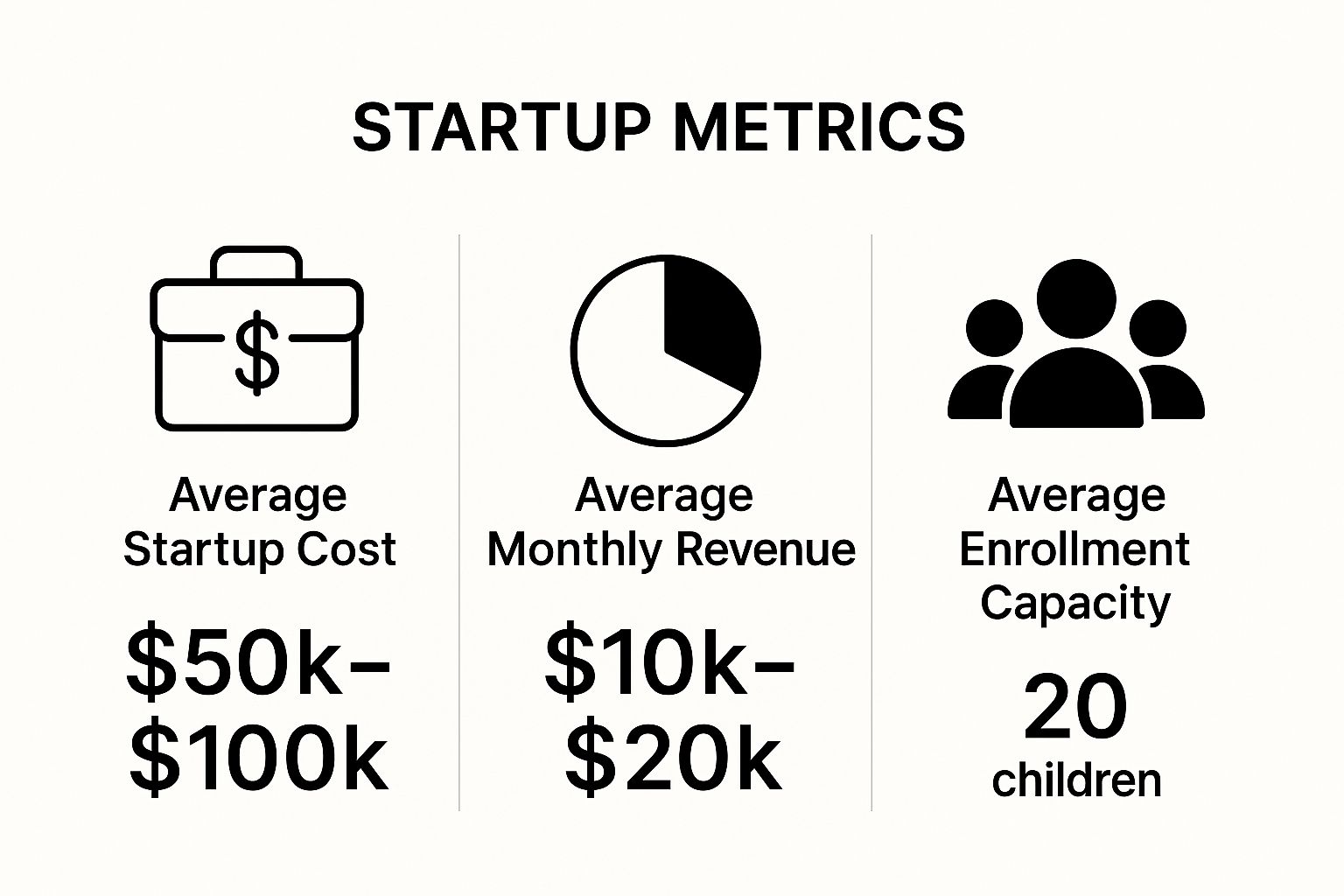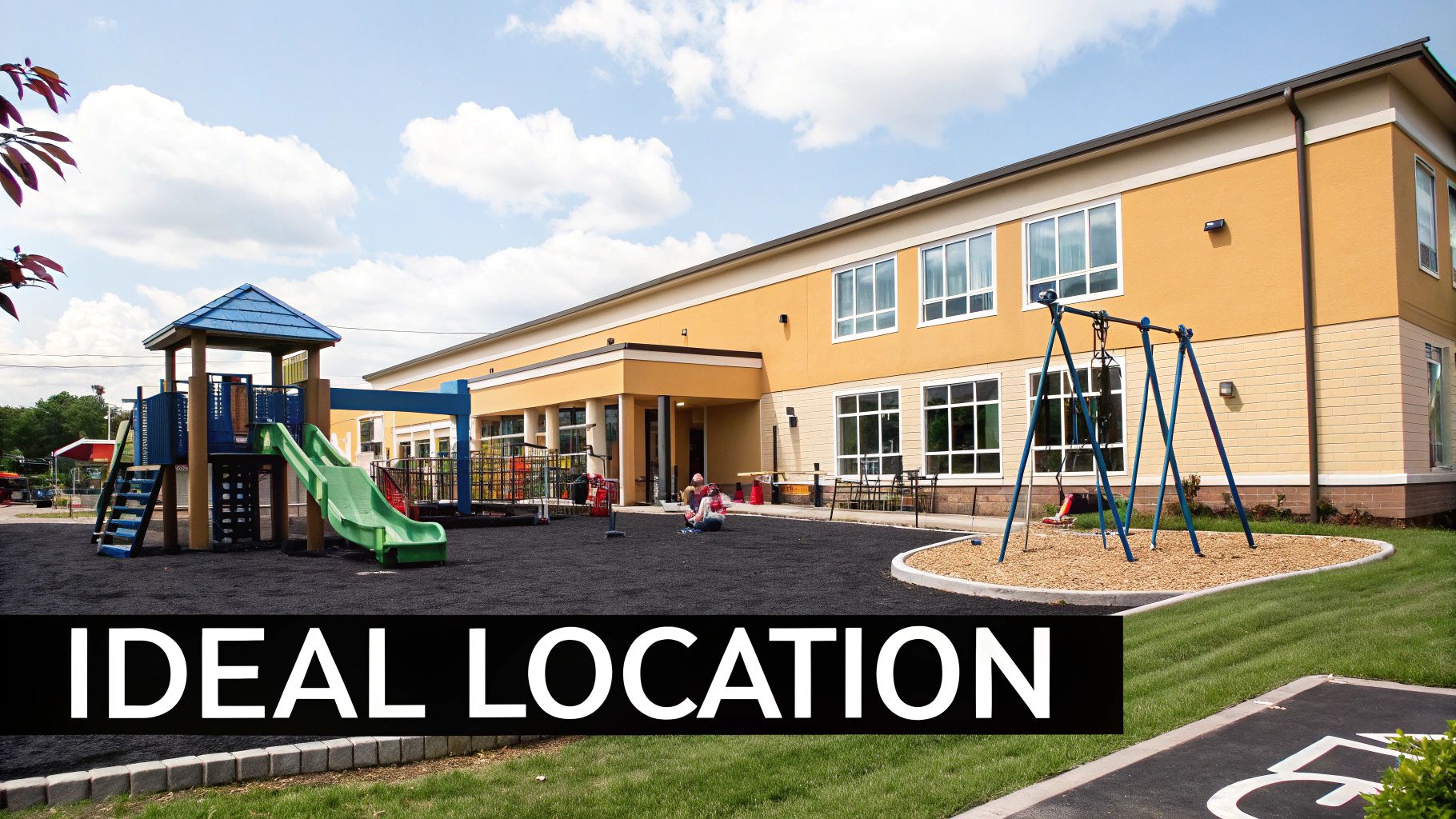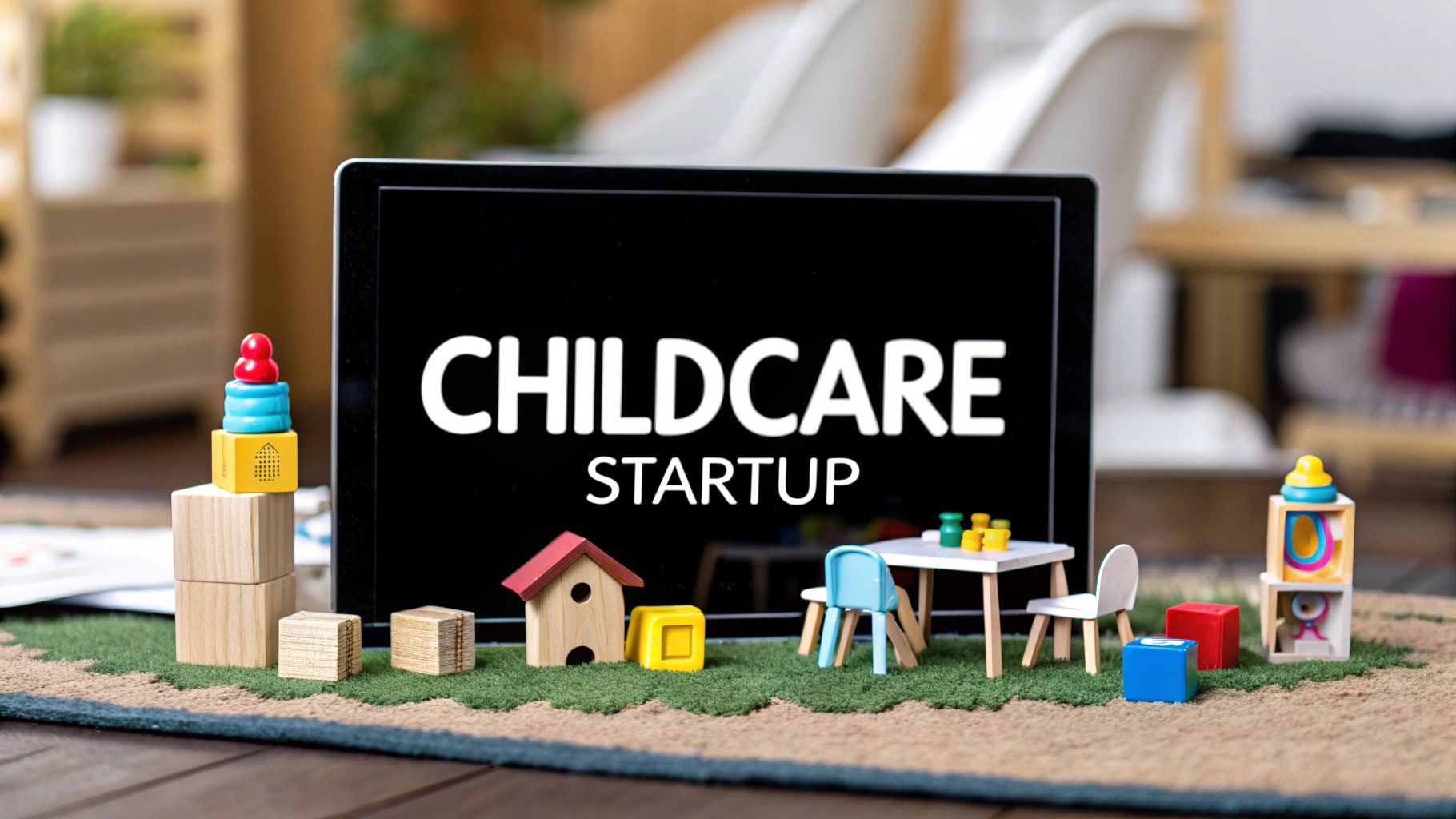Before you can even dream about what color to paint the walls or which storybooks to stock, you need a rock-solid business plan. This first phase is all about laying the groundwork for your small business—figuring out exactly what kind of childcare center you want to run and making sure there’s a real need for it in your community. The decisions you make now will shape your entire entrepreneurial journey.
Laying the Groundwork for Your Childcare Business
The childcare industry isn't just about shaping young minds; it's a massive economic force. The global market is projected to blow past $240 billion in 2025 and is on a trajectory to hit an incredible $422.94 billion by 2035. This isn't just a number—it's a clear signal of the immense and growing demand from parents for quality early childhood education, creating a significant opportunity for small entrepreneurs.
Choosing the Right Business Model
Your first big decision as an entrepreneur is selecting a business model. This choice impacts everything from your startup budget and potential enrollment to your day-to-day operations. It's the foundation of your small business.
Most new entrepreneurs start down one of two paths:
- In-Home Daycare: This is often the most accessible starting point for a small business owner. You'd be caring for a small group of children right in your own home. The startup costs are much lower, and the regulations are usually simpler. It’s perfect for creating a warm, family-like environment and allows you to test the market with minimal risk.
- Commercial Center: This means leasing or buying a separate, dedicated building. It's a much bigger financial leap but offers greater potential for scaling your business. This model lets you serve more families and build a distinct brand, whether you're passionate about Montessori, Reggio Emilia, or a play-based philosophy.
To help you visualize the possibilities, here's a look at some of the common business models you might consider as a new entrepreneur.
Comparing Childcare Center Business Models
| Model Type | Typical Capacity | Startup Cost | Key Advantage |
|---|---|---|---|
| In-Home Daycare | 4-12 children | Low | Low overhead & home-like feel for a solo entrepreneur |
| Small Commercial Center | 20-50 children | Moderate | Scalable & more service options for a growing business |
| Large Commercial Center | 50-100+ children | High | High revenue potential & brand building opportunities |
| Specialized (e.g., Montessori) | Varies | Moderate-High | Attracts a specific, dedicated clientele for a niche market |
Choosing the right model is about balancing your entrepreneurial vision with your financial reality. Don't just pick what seems most profitable; pick the model you can realistically launch and manage as a small business.
This infographic gives a great breakdown of the numbers involved in a small commercial center.

These figures really drive home the financial commitment, but they also highlight the business potential if you get your model and plan right.
Conducting Practical Market Research
You can have the most beautiful facility and the best curriculum, but if your business doesn't solve a problem for local parents, it won't succeed. Your mission here is to find a gap in your local market that your small business can fill. Is your neighborhood full of families with two working parents who need care from 7 a.m. to 6 p.m.? Is there a desperate need for high-quality infant care, or maybe an after-school program for elementary kids?
Your childcare center's success depends on aligning your services with the specific, unmet needs of your local community. Don't build what you think they want; build what your market research proves they need.
Start digging into the local data like a true entrepreneur. Look at demographics, income levels, and the number of other childcare providers nearby. Analyze your future competitors—what are their hours, their rates, their philosophies? This analysis is how you'll define what makes your business different and better. It’s your unique selling point that will convince parents to choose you.
From the very beginning, it’s wise to get your financial house in order. Many new small business owners find incredible value in working with professionals who offer specialized accounting services for Early Childhood Education (ECE) centers. Getting the numbers right from day one is the key to building a stable, long-lasting business that truly serves your community.
Crafting a Business Plan That Attracts Funding
Think of your business plan as the architectural blueprint for your childcare center. For a small entrepreneur, this is the most critical document you'll create. It’s far more than something you hand to a lender; it's your personal roadmap for navigating the challenges and opportunities you'll face. A solid business plan shows potential investors that you’ve thought through every single detail of your venture.

This process transforms your passionate idea into a viable business. It's where you prove that your vision for an amazing childcare center is also a sound financial investment.
What Makes Your Center Special?
Before writing your plan, you must answer one pivotal question: What makes your childcare center different? This is your unique value proposition (UVP), and for a small business, it needs to be laser-focused.
Your UVP is the core promise you're making to families. It’s the single reason they’ll choose your small business over a well-known competitor. Maybe you'll offer extended hours, a STEM-focused curriculum, or an all-organic meal plan.
- Small Business Example 1: A center in a busy city might build its entire program around a nature-based curriculum. For city kids, that's a huge and unique draw.
- Small Business Example 2: An in-home provider could specialize exclusively in infant care. This creates a quiet, nurturing environment that bigger centers can't match, appealing to a specific niche market.
Your UVP shouldn't just be a footnote; it should weave through every part of your business plan, from your marketing plan to your staffing strategy. It’s the heart of your brand.
Getting Real with Your Financials
Let's be honest: the financial section is where lenders and investors will spend most of their time. They need to see you have a rock-solid grasp on the numbers and a realistic path to profitability. This isn't the place for wishful thinking.
Your financial forecast needs to cover three main bases:
- Startup Costs: List every one-time expense required to open. Go beyond rent and furniture. Include licensing fees, insurance, playground equipment, curriculum materials, initial marketing costs, and—this is crucial—a cash reserve for the unexpected.
- Operational Expenses: These are your monthly, recurring costs. Itemize everything: staff salaries, utilities, food, supplies, software, and your ongoing marketing budget. Underestimating these is a common mistake that can sink a new business.
- Revenue Projections: Map out your income based on tuition and enrollment. Create best-case, worst-case, and realistic scenarios. For instance, what does revenue look like at 50%, 75%, and 100% enrollment for the first two years? This shows lenders you’ve planned for a slow start.
A detailed financial projection isn't just about securing a loan. It's about setting tuition rates at a level that ensures your business is sustainable. Keep in mind that U.S. families can spend up to 16% of their median income on care for just one infant.
Structuring Your Plan for Maximum Impact
While templates can give you a starting point, your business plan needs to tell a compelling story about your specific vision. A great business plan fills generic headings with convincing, specific details.
Here’s how to frame the core parts of your narrative:
- Executive Summary: Your elevator pitch on paper. Write it last, but put it first. In one page, it should cover your mission, UVP, financial needs, and why you're the right entrepreneur to succeed.
- Company Description & Services: Get specific about what you’re offering. Detail your hours, age groups served, and the educational philosophy that is the backbone of your curriculum.
- Market Analysis: Put your research to work. Show you understand local demand, pinpoint your target families, and break down your top three competitors. What are their strengths and weaknesses? How does your UVP give you an advantage? To dig into this crucial step, explore what goes into a professional feasibility study for your business plan.
- Management Team: Brag a little! Highlight the experience of yourself and any key team members. If your director has 15 years of ECE experience or a partner has a strong finance background, showcase it. This builds confidence in your ability to execute the plan.
Getting Licensed and Handling the Legal Stuff
Alright, you've got your business plan ironed out. Now comes the part that can feel like a mountain of paperwork: the legal and licensing maze. Don't let it intimidate you. For a small business owner, tackling these requirements methodically is crucial. Getting this right from day one builds a rock-solid foundation and establishes trust with families.
And it’s a great time to be getting into this field. The demand for high-quality childcare is massive—the U.S. market is expected to pull in $65.15 billion in 2024 alone, with experts predicting it will climb to a staggering $109.88 billion by 2033. Parents are heading back to the office and new government funding is popping up, making childcare centers more essential than ever. If you want to dig deeper, you can explore more about U.S. childcare market trends to see just how much opportunity is out there for small entrepreneurs.
Cracking the Code on Childcare Licensing
Every state has its own rulebook for childcare, and these rules are not suggestions. Your first move is to pinpoint your state's specific licensing agency. It's usually part of the Department of Health and Human Services or a similar state office. These are the folks who set the absolute minimum standards you have to meet to open your doors legally.
While the specifics change from state to state, they all focus on the same core things. You can bet you'll see strict rules on:
- Staff-to-Child Ratios: This is a big one. They'll have very clear mandates on how many caregivers you need for a certain number of kids, and it changes drastically by age. The ratio for a room full of infants is going to be much tighter than for a group of four-year-olds.
- Background Checks: Expect everyone to go through them. Every teacher, assistant, volunteer, and sometimes even people living in the home (for home-based daycares) will need to pass a thorough criminal background check. There’s no cutting corners here.
- Training and Qualifications: Your staff can't just walk in off the street. They'll need current certifications in things like pediatric First Aid and CPR. For your director and lead teachers, the bar is even higher, often requiring a degree or significant coursework in early childhood education.
Getting Your Facility Up to Health and Safety Codes
Your physical space is going to be put under a microscope, and for good reason. A licensing inspector will walk through your center with a fine-toothed comb to ensure it’s a completely safe environment for little ones. This goes way beyond just being tidy.
Try to see your center through the eyes of a curious toddler—what could they get into? The inspector certainly will. They’ll be checking for:
- Electrical outlets that are securely covered and cabinets with child-proof locks.
- Playground equipment—both inside and out—that’s in good repair and meets safety standards.
- All cleaning supplies and any potentially hazardous materials stored well out of reach.
- A dedicated, sanitary station for diaper changes.
- Emergency evacuation plans posted where everyone can see them.
Pro Tip: Your state's licensing handbook is your new best friend. Seriously, treat it like your bible. Use it as a checklist to walk through your facility yourself before the official inspection. It’ll help you catch any small details you might have missed.
Locking Down the Right Business Insurance
Licensing is just one piece of the puzzle. Protecting your small business with the right insurance is non-negotiable. A generic business policy won't cut it—you need coverage designed specifically for the unique risks that come with caring for children.
When you talk to an insurance agent (and make sure they specialize in childcare!), these are the policies you need to have on your radar:
| Insurance Type | What It Actually Covers | Why You Absolutely Need It |
|---|---|---|
| General Liability | This is for "slip-and-fall" scenarios. Think a parent tripping on a toy during pickup and getting injured on your property. | It’s the baseline coverage every business with a physical location needs. |
| Professional Liability | Often called "Errors & Omissions," this covers claims of negligence. If a child gets hurt and a parent alleges it was due to a staff member's mistake, this is what protects you. | This is arguably the most critical policy for a childcare center. It protects you from the most serious kinds of lawsuits. |
| Commercial Property | Covers your building and everything in it—from the cribs and changing tables to the toys and curriculum materials. | You're investing a lot of money in your center's physical assets. This makes sure that investment is protected from fire, theft, or other damage. |
| Workers' Compensation | If one of your employees gets injured on the job, this provides them with wage and medical benefits. | As soon as you hire your first employee, most states legally require you to have this. |
Designing Your Learning Environment and Curriculum
With your business plan locked in and the legal paperwork sorted, it's time to dive into the most rewarding part: creating the world where children will play, learn, and truly thrive. The physical space and the educational program you build are the heart and soul of your childcare center.

This is where your vision comes to life. A thoughtfully designed environment does more than just impress parents on a tour; it actively supports child development and becomes a place kids are genuinely excited to come to every single day.
Creating a Safe and Stimulating Physical Space
Safety is non-negotiable. Before you even think about paint colors, your space has to meet—and ideally, exceed—every single licensing requirement. Think covered outlets, child-proof locks, and secure storage for all supplies.
But safety is just the baseline. How does the space feel? Can children move freely between activities without tripping over each other? Is it bright and inviting?
A fantastic way to achieve this is by setting up distinct learning centers. This approach carves up the room into manageable, purposeful zones.
- Quiet Corner: A cozy nook filled with soft pillows, blankets, and a library of books for kids who need a calm moment.
- Creative Arts Center: An area with easels, finger paints, clay, and craft supplies where getting messy is part of the fun.
- Dramatic Play Area: A space stocked with costumes, props, and maybe a play kitchen to spark imagination and social skills.
- Building Zone: A spot dedicated to blocks, LEGOs, and other construction toys that build problem-solving and fine motor skills.
These zones don't just prevent chaos; they empower children to make their own choices, a cornerstone of healthy development. If you're looking for inspiration, checking out some inspiring daycare room setup ideas can get the creative juices flowing.
Choosing Your Educational Philosophy and Curriculum
Your curriculum is your educational roadmap. It defines the "what" and "how" of a child's learning journey at your center. As a small business owner, this choice should be a direct reflection of what makes you special. Are you play-based? Academically focused? Or maybe you're drawn to a specific methodology like Montessori or Reggio Emilia?
Whatever you land on, it must be developmentally appropriate. This simply means the activities and expectations are perfectly matched to the age group you serve. What works for a curious four-year-old is worlds away from what a toddler needs.
Your curriculum isn't just a binder of lesson plans; it's the tangible expression of your mission. It's how you deliver on the promise you make to parents about nurturing their child's potential.
This is a huge decision that will influence everything from the toys you buy to the teachers you hire. A top-notch curriculum is a massive selling point, especially now. The global day care market is expected to hit $66.21 billion in 2025 and is projected to skyrocket to $102.89 billion by 2032, driven by parents who understand the benefits of quality early education.
Structuring the Day with Purpose
Once you've settled on a philosophy, you need to translate it into a daily schedule. Kids thrive on predictability; a consistent routine helps them feel secure because they know what’s coming next. This doesn't mean a rigid, minute-by-minute plan, but a reliable flow to the day is crucial.
A balanced schedule should weave together different types of activities:
- Group Activities: Think circle time for stories, songs, and show-and-tell.
- Individual Play: Plenty of free time for kids to explore the learning centers on their own terms.
- Outdoor Time: Absolutely essential for physical development and getting the wiggles out.
- Meals and Snacks: Structured, social mealtimes that are about more than just food.
- Quiet/Nap Time: A necessary period for little bodies and minds to rest and recharge.
Building a curriculum and daily schedule from the ground up is a serious undertaking. The good news? You don't have to reinvent the wheel. To see how these pieces all fit together within a complete operational framework, take a look at our sample business plan for a childcare center. It provides a solid blueprint to ensure your day-to-day operations are just as strong as your educational vision.
Building Your Team And Marketing Your Center
You’ve designed a welcoming space and crafted a curriculum—but two elements make it all work: your team and your marketing plan. Your educators bring your vision to life, while your marketing ensures families find you. For a small entrepreneur, mastering both is the key to steady growth.

Assembling A Team That Embodies Your Vision
Hiring for a childcare center isn’t about filling seats—it’s about finding people who share your passion. As a small business owner, every hire is critical. Parents trust you with their children, so every educator must reflect your values.
Start with a job post that tells a story. Describe your unique approach. Spell out the must-have qualities—patience, creativity, communication—and the nice-to-have extras, like CPR certification or specific curriculum experience.
• Craft A Story-Driven Job Description
• Highlight Both Essential And Preferred Skills
• Invite Applicants To Share A Quick “Why I Teach” Video
A stable, happy staff creates the consistent, caring environment kids need. Investing in your team is one of the smartest business decisions you can make.
Once you’ve hired, set clear roles and expectations. An organized structure prevents confusion and empowers your team. For a step-by-step breakdown on building an employee handbook, check out our effective HR handbook.
Crafting A Marketing Plan For A Small Business Budget
You don’t need a huge ad budget to fill your classrooms. For a small business, local, personal outreach often outperforms big-spend campaigns. Your goal is to become the neighborhood’s trusted choice, one family at a time.
Your marketing plan should start with a clean, mobile-friendly website. This is your digital storefront. Include your address, hours, tuition, and philosophy. Use local keywords (e.g., "daycare in [Your Town]") so you appear in local search results.
Here are a few low-cost, high-impact marketing strategies for your plan:
• Community Events: Host a free story time at the local library or set up a booth at the farmers' market.
• Social Media Groups: Be genuinely helpful in local Facebook parent groups. Answer questions and build relationships—avoid hard sells.
• Open Houses: Invite local families for tours to see your center in action.
Essential Marketing Channels for a New Childcare Center
Below is a quick reference for your marketing plan. Focus on the channels that give you the most visibility in your local area.
| Marketing Channel | Estimated Cost | Target Audience | Key Benefit |
|---|---|---|---|
| Local SEO & Website | Low (DIY) to Moderate | Parents actively searching for childcare nearby | High-intent leads showing up exactly when they’re ready |
| Social Media Groups | Free | Local moms, dads and parent communities | Builds trust and sparks word-of-mouth |
| Community Events | Low | Families living within a few miles | Personal interactions that leave a lasting impression |
| Referral Program | Performance-based | Current families and their networks | Turns your happiest clients into your best ambassadors |
This mix helps you reach families right where they are—online and in person—without breaking your small business budget.
Building A Powerful Referral Program
Word-of-mouth is your marketing superpower. A friend’s recommendation carries far more weight than any flyer. Your marketing plan must include a referral program. Incentivize referrals with something tangible—like a $50 tuition credit for both the existing family and the newcomer.
That small credit can spark a chain reaction of enrollments, building a community on trust. Keep the process simple: a quick form, an email reminder, and clear terms. Before you know it, your waiting list will be your strongest marketing asset.
Common Questions About Starting a Childcare Center
As you get ready to open your doors, a few big questions always seem to surface. It's completely normal for a new entrepreneur. Let's walk through some of the most common ones—getting these answers straight will give you a much clearer path forward for your business.
How Much Does It Really Cost to Start a Childcare Center?
The honest answer? It varies wildly based on your business model and location.
If you're starting a small in-home daycare, you might only need a few thousand dollars for licensing fees, child-proofing, and initial supplies. This is a common entry point for solo entrepreneurs.
On the other hand, opening a commercial center is a significant investment, potentially from $50,000 to over $250,000. This covers a property deposit, renovations to meet safety codes, playground equipment, and your initial marketing budget. Your financial projections in your business plan are critical for securing the necessary funding.
What Is the Most Important Factor for a New Daycare's Success?
A prime location and a great curriculum are important, but your staff will make or break your business. Nothing is more important. Parents are placing ultimate trust in your business, and that trust is really in the hands of the educators who interact with their children every day.
A team of genuinely caring, qualified, and passionate teachers becomes your most powerful asset and your biggest competitive advantage. When parents feel their kids are loved and safe, they become advocates for your brand. That word-of-mouth buzz is more effective than any paid ad. Focus on creating a great work environment to attract and keep the best people.
How Do I Determine the Right Tuition Fees?
Setting tuition is a delicate balance between your costs, the local market, and your desired profit margin.
First, calculate your break-even point. Add up every single monthly operating expense—rent, payroll, insurance, food, supplies—and determine that cost on a per-child basis. This is the minimum you must charge to keep the doors open.
Next, research what other local centers are charging. Your pricing needs to cover costs and generate profit, but it also has to be competitive. Consider offering different rates for full-time and part-time spots, and always be transparent about what is and isn't included in your fee.
Keep in mind that for many families, childcare is a significant expense. The U.S. Department of Labor notes that families can spend up to 16% of their median income on care for just one infant, making value and quality paramount.
What Kind of Insurance Is Absolutely Necessary?
As a small business owner responsible for children, a few specific insurance policies are non-negotiable. Find an insurance agent who specializes in the childcare industry to ensure you have the right coverage.
At a bare minimum, your business will need:
- General Liability Insurance: Your basic slip-and-fall coverage for accidents on your property.
- Professional Liability Insurance: Crucial for covering claims of negligence related to the professional care you provide.
- Workers' Compensation: Almost always a legal requirement if you have even one employee, covering them if they are injured on the job.
Planning is often the steepest part of the climb for any entrepreneur. If you're feeling stuck, GrowthGrid can help you map everything out. It uses AI to help you build a detailed, professional business plan in a fraction of the time. Just answer a few questions about your vision, and it generates a complete roadmap—from financial projections to marketing strategies—that can help you secure funding and start your childcare center with confidence. Create your business plan with GrowthGrid today.
